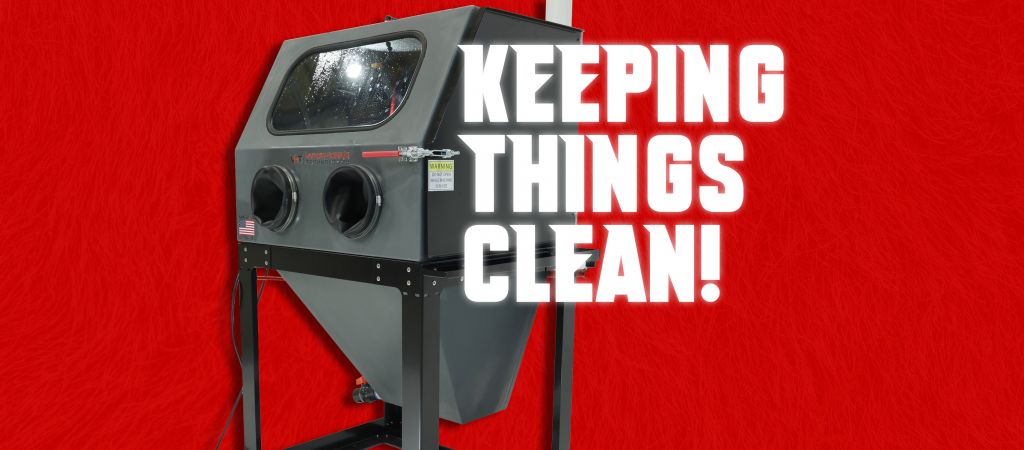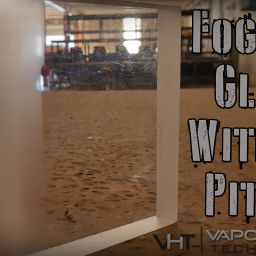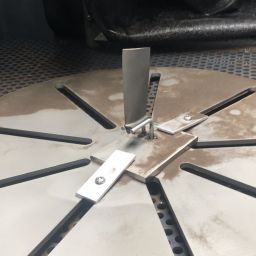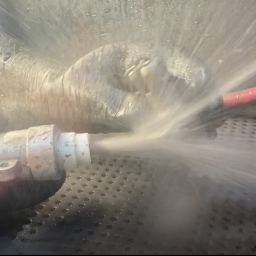
Maintenance for Wet Blasting Cabinets
Regularly maintaining vapor honing systems is essential to ensure optimal performance, consistent media flow, and equipment longevity. On a daily basis, users should inspect and rinse the blast nozzles to prevent clogging, while also checking the slurry mix itself for proper consistency—too thick and it won’t flow well; too thin and it can compromise blasting power. (A ratio of 80:20 water to abrasive is typically ideal) Operators should also top off water and abrasive levels as needed and wipe down the cabinet’s viewing window and lights for optimal visibility. The operator should also rinse the walls and inside the door to get loose abrasive back into the slurry.
Maintenance every other week includes draining and cleaning the slurry tank, particularly if the machine is in frequent or industrial use. Filters—especially those protecting the slurry pump—should be cleaned or replaced depending on the system design. Technicians should also inspect the pump impeller and agitation system for any build-up of contaminants that might inhibit performance.
For machines equipped with a Closed Loop System, additional upkeep is necessary. These systems recirculate water and slurry, minimizing water usage and environmental waste. However, to maintain proper function, the filtration unit must be flushed at least weekly to avoid clogging. The filter media should be replaced approximately every month or sooner depending on contamination levels. Even though the Closed Loop system reduces the frequency of full water changes, the entire system should still be drained and deep-cleaned periodically.
Maintenance for (Aqueous) Parts Washers
Parts washers from Vapor Honing Technologies are designed to operate using heated water and detergent, not harsh solvents making them both effective and environmentally responsible. For daily use, it’s important to check and clean the spray nozzles and internal manifolds to ensure they’re not blocked by debris. Water levels should be topped off as needed, and the turntable screen or basket should be cleared of any parts residue.
Weekly, operators should skim floating oils or debris from the surface of the water to maintain detergent effectiveness. Inline filters or strainers also need cleaning, and the heating element should be checked for buildup. On a monthly basis, the washer should be fully drained and cleaned inside, with a complete fluid replacement using fresh detergent. At this time, operators can also introduce additives like rust inhibitors or water conditioners depending on part material and application.
Maintenance for Sandblasting Cabinets
Dry blasting systems require a separate set of upkeep practices centered on airflow, dust control, and abrasive quality. Daily, operators should empty the dust collection tray or vacuum out the filter bag, depending on which your cabinet is equipped with. Nozzles and abrasive feed lines should be cleared and inspected for any clogs or media blockage.
Each week, the abrasive media itself should be sifted or screened to remove contaminant buildup. Additionally, the blasting nozzle and air jet must be checked for wear, as even slight erosion can reduce blasting efficiency or cause uneven finishes. Cabinet seals, glove ports, and lighting lenses should be cleaned and checked to maintain interior pressure and visibility.
Monthly tasks include deep cleaning the dust collector’s hoses and replacing the filters if they’re overly clogged or beginning to break down. Good airflow is critical in these systems—not only for dust control but also for visibility and safety—so the exhaust system should be tested to ensure its functioning properly. Overall, cleaning up after a sand blast cabinet is a more pressing concern due to how things can get out of hand faster, thanks to shooting straight abrasive without water to cushion the impact.
Concluding Thoughts
The most important thing when it comes to cleaning up your cabinets after use is having a schedule and sticking to that schedule. It does no good to be aware of what cleaning is most needed for your machine if you cannot perform the Maintenace on a regular basis. Also, you may not even be aware of what cleaning needs to be done if it is not recorded down for future reference. Hopefully this blog was helpful for you, If you would like to do further reading into what type of surface finishing best meets your needs, we have a blog post here discussing what blasting method works best in an industrial environments. Have a good rest of your day!








